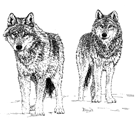Center, Internet, Wildlife Damage Management

Rocky Mountain Wolf Recovery: Annual Reports
Date of this Version
2012
Citation
Montana Gray Wolf Program (2012)
Abstract
Gray wolves primarily live in habitat that supports deer and elk. As a result, wolves sometimes use areas that are in close proximity to humans, particularly in and around deer and elk habitat in rural areas. Wolves can be legally killed if seen attacking dogs, chasing or attacking livestock, or to protect human life. For those living and recreating in wolf country, here are some tips on how to decrease the potential for conflicts.
HUMAN SAFETY
Wolf attacks on people are very rare. Most wolves fear people and will run when encountered. However, wolves are visual learners and some may stop and stare. All wildlife can be dangerous and should be given distance and treated with caution. There have been a small number of documented wolf attacks on people in North America and contributing factors were most often related to habituation to people and/or conditioning to human foods. In areas where people live near wolf habitat it is especially important to follow these steps to discourage habituation:
AT HOME
Do not feed wolves or leave food outdoors, including pet food.
Do not feed deer, turkeys, or other wildlife that may attract wolves or other predators like lions and bears.
If wolves are seen close to people or human-inhabited areas, scare them away by making loud noises.
Report wolves that seem comfortable around people, seek human food, or frequent human-inhabited areas to FWP (see contact info on back of handout).
Hikers, campers, and hunters are more likely to come upon areas of wolf activity such as a kill site, denning area, or resting site. After detecting a person’s presence, some wolves may lope off quietly, others may bark or howl, or some may cautiously approach to get a better look. Hearing wolves barking and howling all around can be loud and startling. However, encountering wolves at close range is seldom a reason for alarm (unless you have a dog; see dog section on back) especially if you know what to expect. Once wolves have identified the disturbance, they generally leave the area. Vocalizing could go on for awhile as wolves regroup out of sight and pull back from the situation. If a wolf is killed, other wolves generally move off but may return to the site later. Here are some tips on what to do and how to avoid close encounters.
IN THE FIELD
Avoid areas of wolf activity including fresh wolf kills and denning areas. Do not approach wolves.
In the event of a close encounter, be calm and slowly leave the area. If approached, stand tall and make noise.
Hunters: hang game meat out of reach. Wolves may feed on gut piles and carcasses left out overnight but will usually move off upon your return.
Always carry pepper spray for any potential close encounter with wildlife.

